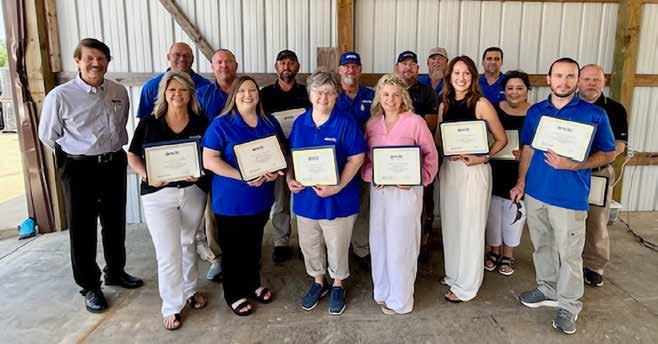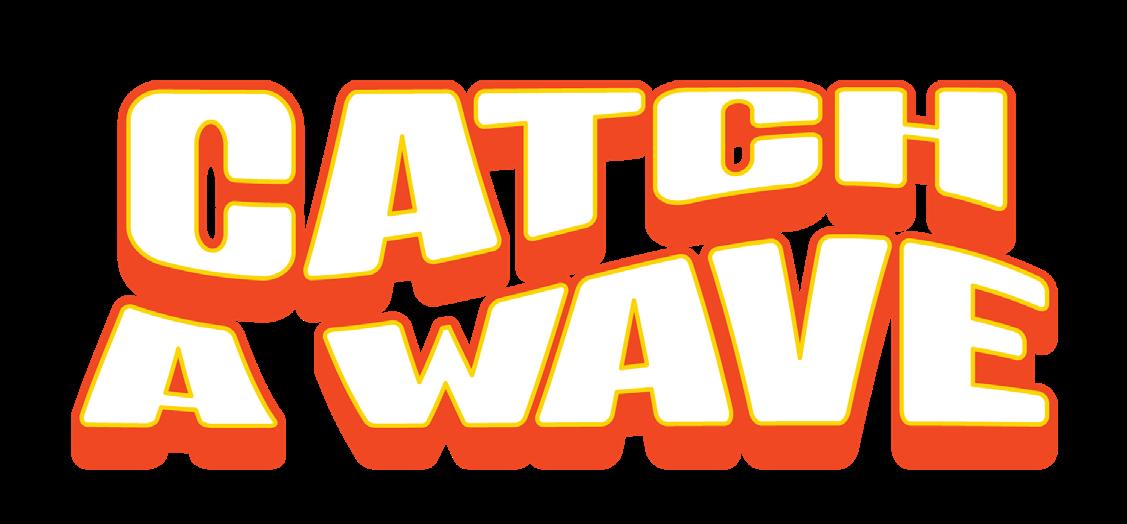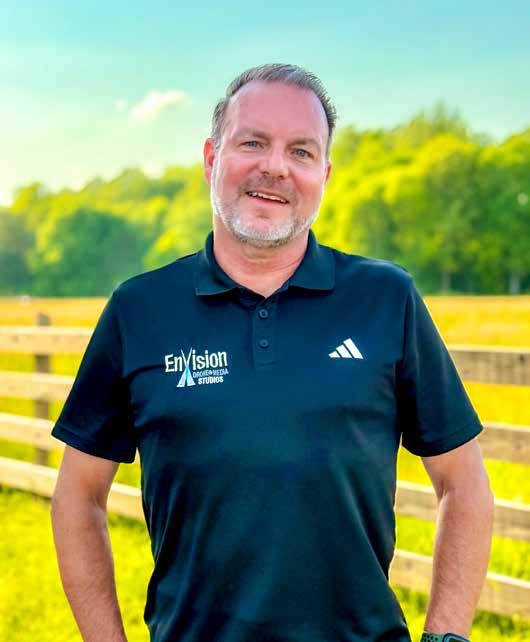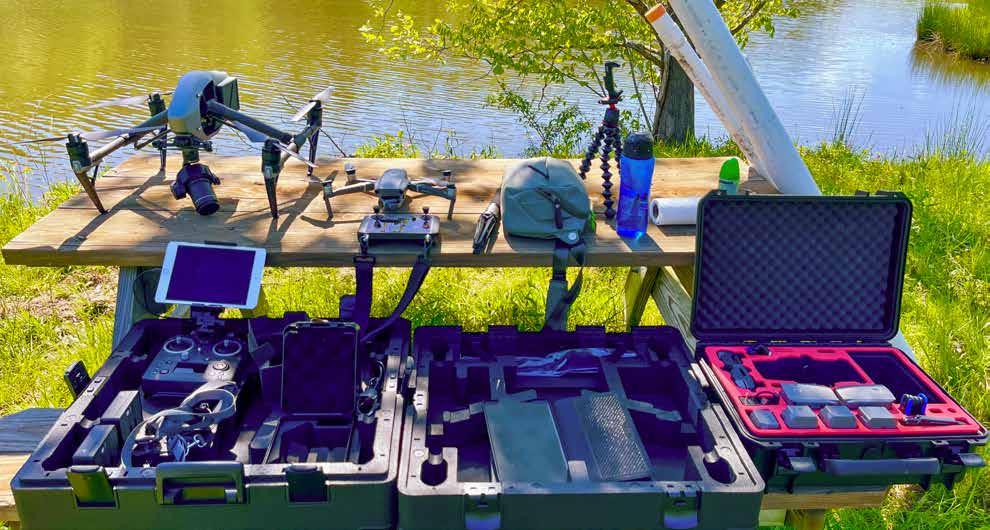



Flying High
Drone tech in Westmoreland
HALTON GROWS SUMMER FOOD






HALTON GROWS SUMMER FOOD

By Shirley Bloomfield, CEO NTCA–The Rural Broadband Association
Celebrate decades of digital innovation
World Wide Web Day is Aug. 1. It’s a celebration of a 1993 internet milestone that transformed our society, changing everything from work and health care to communications and entertainment.
Before the web, accessing information and resources on the interconnected computers spanning the globe required specific software and skills. Email use was even limited—in business, fax machines still ruled. Then, researchers in Switzerland, including Tim Berners-Lee, developed the World Wide Web. Not only was information easier to share, but the freely distributed tools that made it possible fueled decades of innovation.
Now, rural internet service providers like yours manage the high-speed networks unlocking the modern web. NTCA’s 2024 Broadband/Internet Availability Survey Report showed that 89% of rural customers served by providers responding to the survey have access to speeds of at least 100 Mbps.
That’s a dramatic change compared to 1993, when connecting was slow and noisy, reliant on dial-up modems and copper lines. Back then, a speed of 14.4 Kbps was great—nearly 7,000 times slower than a 100 Mbps connection today.
Students can now access endless resources online and attend virtual classes. Telemedicine brings services and specialists otherwise unavailable in rural communities. Farmers monitor crops, manage resources and keep livestock healthy with internet-connected tools. And that’s only the beginning.
NTCA members across rural America make it all possible. So, let’s take a moment to celebrate not only World Wide Web Day, but also the communications professionals in your community.
Thank you for all you do.
Local businesses are a cornerstone of the United States’ economy, particularly in rural communities. You need to look no further than your local utility providing a fast, reliable internet network. Companies like these are not only committed to providing excellent service but also uplifting their communities.
A report last year by Capital One Shopping, a site operated by the banking and credit card company, highlighted the importance of local retailers.
• In one week, 91% of American consumers shop at small and local stores.
• 68%, or $68 out of every $100, spent at local stores remains in the local economy.
• American shoppers spent an estimated $4.51 trillion at local stores in 2023, equivalent to 54.3% of all retail sales
• The average person shops locally 213 times per year or once every 1.7 days
• Shopping small keeps dollars local.
• Dollars spent at an independent business may recirculate in the local economy an average of six to 15 times
• Small businesses make up to 136% more charitable donations per employee than businesses with 500 or more employees.
• Residents of communities with more independent businesses drive three-quarters fewer miles than their neighbors who have less access to small local shops.

Long days outdoors are a joy of summer. A little sun can even increase your vitamin D levels, which has a range of health benefits. On the other hand, bathing in too much sunlight is not good for the skin, raising the potential for skin cancer. And some people are more susceptible than others.
So, it just makes sense to track and manage sun exposure. Think about all the things we already monitor—steps, sleep and even what we eat. Why not also track exposure to ultraviolet light, the rays produced by the sun?
In fact, your phone’s weather app may already offer a forecast for expected sun exposure at your location. Other apps though can ramp up the details. Early UV apps were basically glorified timers with general advice tacked on. Today’s versions
are more sophisticated, providing information on everything from cloud cover to how much sun is reflecting off surfaces around you.
These apps often have easy-to-understand color-coded displays that show your risk level. Most will customize their recommendations based on your skin type, which means you’re getting advice that’s relevant to you specifically.
Some of the more advanced options do more than track UV exposure. They can use your smartphone’s camera to analyze your features and suggest proper levels of sun protection. Many will even send timely reminders when it’s time to reapply sunscreen based on your activity level and which products you’re using.
The more comprehensive sun safety apps don’t only monitor UV rays. They
include educational content about sun damage and skin cancer prevention. Some even track vitamin D production, helping you balance protection with healthy sun exposure.
Family-friendly versions allow users to set up profiles for multiple family members with different skin types, making it much easier to manage sun protection during group outings like beach days or picnics. Of course, no apps replace a proper checkup with your dermatologist, but they do offer daily reminders about a danger we can’t always see. So, next time you’re heading outdoors for a day in the sun, check the app store for your favorite device and see if there’s an app that provides the details you need to stay safe. At minimum, the apps can keep the importance of skin protection top of mind.
Ialways enjoy these long, sunny days, which are perfect for slowing down and spending time with family and friends. It’s an opportunity to unplug and enjoy the outdoors, and at NCTC we believe the communications services we provide can help connect us in person and online.

JOHNNY MCCLANAHAN President/CEO
Have you ever noticed how we can all get stuck looking at our phones? Even though our internet connects thousands of homes and businesses, the best connections often happen when we look up and see each other face to face. This summer, I invite everyone to find that sweet spot, using our internet to make your real-life gettogethers even better.
Think about that family reunion you’re planning. Group texts make organizing easy. Video calls let you chat with relatives who moved away. When everyone finally gets together, your phone can capture precious moments and then store, edit and share those images online. Fast reliable internet makes it all possible.
Similarly, our local markets and festivals thrive because vendors can easily process card payments without the need for expensive and complex systems. And they can keep potential customers updated by posting online about sales and new products. But being out and about shopping is still an opportunity for connections where neighbors meet in person, shake hands and catch up.
Also, thanks to rich and affordable streaming services for music and video, families can gather indoors or outside for movie nights. Perhaps some things that start small can grow into monthly traditions where neighbors become friends.
At NCTC, we don’t just support a fast, industry-leading internet service. We believe these resources can create paths to new possibilities. Your stories of connection and success fuel our passion—grandparents who video chat with grandkids, local businesses that ship to customers around the nation or young artists sharing digital creations with the world.
This summer, try using technology with purpose. Create a shared family photo album that relatives can add to from anywhere. Use social media to organize a park cleanup day. Stream music for an impromptu block party. Record video interviews with town leaders to save and share their stories.
The best communities blend new technology with cherished traditions. At NCTC, our investment in this community allows us to use technology to make our ties to one another stronger. As we enjoy summer, remember that our most important connections will always be with each other. We are proud to provide the technology that helps those connections grow. Let’s make this a summer of real connection, both online and in person.
The North Central Connection is a bimonthly newsletter published by NCTC, © 2025. It is distributed without charge to all member/ owners of the cooperative.


North Central is a member-owned corporation dedicated to delivering advanced telecommunications technology to the people of Northern Middle Tennessee and Southern Kentucky, including Macon County, Tennessee, Allen County and Warren County, Kentucky. NCTC also serves portions of Sumner, Trousdale, Smith and Clay counties in Tennessee.
North Central
872 Highway 52 Bypass E. P.O. Box 70 Lafayette, TN 37083
Telephone: 615-666-2151 nctc.com
Glen Hardcastle
Chairman of the Board
Scottsville Exchange West
Randy Harston
Vice Chairman of the Board
Scottsville Exchange East
Calvin Graves
Secretary of the Board
Bethpage/Oak Grove Exchanges
Martha Bowser
Westmoreland Exchange
Kevin Dickerson
Defeated/Pleasant Shade Exchanges
Donnie Steen
Lafayette Exchange East
Jeff Flippin
Lafayette Exchange West
Chad Evitts
Hillsdale/Green Grove Exchanges
Chad Owens
Red Boiling Springs Exchange
Johnny McClanahan
President/CEO
Guy Holliman
General Counsel
Produced for North Central by:
On the Cover:

Michael Sands, a Westmoreland entrepreneur, uses drones to help businesses build their brands.
See story Page 12.

NCTC recently recognized a group of employees celebrating milestone anniversaries as members of the cooperative’s family. Thank you all for your service and dedication.
Katrina Brown, 10 years
Shay Tom Clariday, 25 years
Justin Cline, 5 years
Tim Collins, 25 years
Dwayne Colter, 25 years
Troy Davis, 25 years
Jeremy Dillehay, 25 years
Amberia Driver, 10 years
Amy Fryman, 15 years
Laura Law, 15 years
Cassy Sullivan, 5 years
Chad Swindle, 25 years
Penney Whittemore, 5 years
Matt Wyatt, 25 years
Johnny Young, 25 years
In accordance with federal civil rights law and U.S. Department of Agriculture (USDA) Civil Rights regulations and policies, the USDA, its agencies, offices, and employees and institutions participating in or administering USDA programs are prohibited from discriminating based on race, color, national origin, religion, sex, gender identity (including gender expression), sexual orientation, disability, age, marital status, family/parental status, income derived from a public assistance program, political beliefs, or reprisal or retaliation for prior credible activity, in any program or activity conducted or funded by USDA (not all bases apply to all programs). Remedies and complaint filing deadlines vary by program or incident. Persons with disabilities who require alternative means of communication for program information (e.g. Braille, large print, audiotape, American Sign Language, etc.) should contact the responsible agency or USDA’s TARGET Center at 202-720-2600 (voice and TTY) or contact USDA through the Federal Relay Service at 800-877-8339. Additionally, program information may be made available in languages other than English. To file a program discrimination complaint, complete the USDA Program Discrimination Complaint Form, AD-3027, found online at ascr.usda.gov/complaint_filing_cust.html or any USDA office. Or write a letter addressed to USDA and provide in the letter all of the information requested in the form. To request a copy of the complaint form, call 866-632-9992. Submit your completed form or letter to USDA by: 1) mail: USDA, Office of the Assistant Secretary for Civil Rights, 1400 Independence Ave. SW, Washington, D.C. 20250-9410; 2) fax: 202-690-7442; or 3) email: program.intake@ usda.gov. USDA is an equal opportunity provider, employer and lender.

NCTC wishes you a safe and fun Independence Day. Our offices will close Friday, July 4, in observance of the holiday, but you can still reach us 24 hours a day, seven days a week, 365 days of the year by calling 270-622-2056.


Story by KATHY DENES
If summer has a signature scent aside from freshly mowed grass, it’s the chlorine of swimming pools and water slides. Water parks are the ultimate hot-weather attractions, and some have been popping up lately that go far beyond splash pads and lazy rivers. These parks lure the adventurous with endless waves and whitewater for rafting, kayaking, canoeing and even surfing—no wild oceans or rivers required.
The first of these parks in the country, the U.S. National Whitewater Center in Charlotte, North Carolina, is home to a whitewater river that challenges even the most experienced wave riders. Touted as the world’s largest artificial river, its recirculating treated water flows along dual concrete channels offering rapids
varying in intensity from Class II to Class IV.
The sprawling facility is geared to all sorts of outdoor recreation and is still evolving nearly 20 years after opening. Guided rafts and kayakers with whitewater experience ride the same rapids U.S. Olympic athletes use for training and team trials. The Wilderness and Competition channels provide varying intensity and length before ending in the tranquil pool where riders steer their boats onto a conveyor belt and ride back to the start for another go.
“The USNWC was the first whitewater channel specifically designed for family-level fun at an Olympic-standard facility,” says course lead designer Scott Shipley, an engineer, kayak champion
and three-time Olympian who holds four world titles. “Until Charlotte, every whitewater channel in the world was an Olympic channel first that was later adapted for commercial rafting. We created a channel for family recreational rafting first and then added a competition channel. We focused on the church and school groups that will be using it as a way to help get them active.”
At Riversport OKC in Oklahoma City, Olympic and Paralympic athletes train in rowing as well as canoe and kayak. In fact, it is slated to be the canoe slalom venue for the 2028 Los Angeles Olympics. Its whitewater center offers rowing, kayaking and surfing lessons,


ABOVE: Progressing from bodyboarding to kneeboarding takes very little time with FlowRider’s perpetual waves.
OPPOSITE PAGE: Rafting can get pretty wild on Riverpark Rapids in downtown Oklahoma City.
along with tubing, paddleboarding, highspeed slides and even fun on dry land.
Riverpark Rapids whitewater rafting and kayaking center is in Riversport Adventure Park, in the Boathouse District along the Oklahoma River. Whitewater kayaking and guided rafting start at the top of the artificial river, reached via a conveyor belt. From there, it’s an easy slide into the river to start a memorable ride.
Those ready to Surf OKC can catch a wave, no previous skill needed. Starting with bodyboarding, the staff teaches all the basics to help visitors hang 10. Wipeouts are inevitable, but there are no sharks in the nonstop waters of the FlowRider surf machine. Found all over the world, these compact wavemakers keep endless, shallow water flowing atop a trampolinelike surface.
TEST THE WATERS
Riverpark OKC is open daily 10 a.m. to 5 p.m. in the summer and on weekends in the late spring and early fall. Day passes and memberships are available. Each Thursday through Aug. 7, Riverpark offers NightWater Evening Rafting from 6-8 p.m. riversportokc.org
The Charlotte Whitewater Center will celebrate Independence Day by hosting a free two-day festival, July 3 and 4, with live music and more. Evening events those days include illuminated rafting

one of the six levels of SandRidge Sky Trail.

In the hills above Charlotte, North Carolina, the U.S. National Whitewater Center caters to whitewater enthusiasts ranging from novice paddlers to Olympic athletes.
and kayaking on the river’s Competition Channel, but this requires purchase of an activity pass. See the center’s website for schedules, pass information and events, plus details about any required gear and skill prerequisites. whitewater.org.
Montgomery, Alabama—Whitewater paddlers of all skill levels can enjoy the thrills of rafting or kayaking at Montgomery Whitewater, complete with a 1,600-foot Competition Channel and 2,200-foot Creek Channel. To open its season, Montgomery Whitewater hosted the 2025 Pan American Canoe Slalom and Kayak Cross Championships. It was the site of the U.S. Canoe/Kayak Slalom Olympic team trials for the 2024 Paris games. For more, go to montgomerywhitewater.com.
Sevierville, Tennessee—Before the 2020 opening of Soaky Mountain, surfer Ben Gravy tested its waters, posted his rides on YouTube and declared the park has the “best manmade novelty wave in America—one of the best on the planet.” Soaky Mountain is open daily in July and August and on weekends in September.
Check out soakymountainwaterpark.com.
Rock Hill, South Carolina—Two custom lakes at SouthTown Wake Park await wakeboard riders 7 and older, and there isn’t a boat in sight. Boarders hold ski ropes pulled by overhead cables. Beginners can sign up for lessons on the smaller lake, while the larger lake is equipped with jump ramps and other features that let advanced wakeboarders work on extreme moves. There’s also Aqua Park for paddleboards, as well as an obstacle course on floating inflatables and onshore games.
Get all the details at southtownwakepark.com.
Story by JEN CALHOUN
Big things are happening in Scottsville, and it’s all thanks to a company from Finland. Halton, a company that makes ventilation equipment for everything from hospitals to restaurants and cruise ships, last year increased the size of its local plant, adding 60 more full-time jobs.
The $7.4 million investment includes a 47,000-square-foot expansion of manufacturing space and an additional 8,100 square feet for labs and offices, according to a news release from the company.
“The added space includes a research and development office and lab for the air-moving product line, as well as new manufacturing space for additional product lines to support the overall growth of the business,” the news release says.
The new expansion brings the company’s total operational area in Scottsville to more than 180,000 square feet. The extra jobs bring the company’s total employment in Kentucky to about 240. “Any time we get good-paying jobs with a strong company like Halton, it’s a win for Allen County,” says Dennis Harper, the county's judge-executive. “We’ve had a great relationship with them over the years, and this just takes it to the next level.”
Scottsville Mayor David Burch told a television news crew in 2024 that the company’s long-standing presence in the community shows what can happen when local leadership and global industry work together. “We’re proud to see Halton continuing to invest here,” Burch says. “This expansion reinforces that Scottsville is a great place to do business, and that we have the workforce and support to make it happen.”
The sentiment goes both ways, according to a statement from Mika Halttunen, chairman and owner of

Halton Group, in a news release that announced the expansion.
“Kentucky has been a great home for our U.S. operations for more than 30 years,” Halttunen says. “We are excited to continue growing our team and facilities including setting up a new Innovation Hub and laboratory. This will enable us to provide the highest-quality innovative air-handling products for the domestic U.S. commercial kitchen ventilation market and to export those to the rest of the Americas, Middle East and Asia Pacific.”
The Halton brand is well-known throughout the world when it comes to airflow, ventilation and pollution control in all kinds of commercial buildings and ships. Since its beginning, the company has focused on clean, healthy and safe indoor environments.
The company was founded in Finland by Halttunen’s father, Seppo Halttunen, in 1969, according to information from the Allen County-Scottsville Industrial Development Authority. It came to North America in 1978 with the establishment of a Canadian facility. Its first sales offices in the U.S. opened in 1982. As it continued to expand, the ACS-ID says, Halton became the Halton Group after purchasing or merging with other companies in similar markets.
Halton established its Scottsville plant in 1997 on Industrial Drive off Old Gallatin Road, just south of White Plains. Initially, the plant employed 27 people, according to the ACS-ID.
The new expansion, which was created at the company’s second Scottsville facility, will provide increased capacity
and flexibility for manufacturing as the demand for Halton’s exhaust fans, air systems and pollution control units continues to grow, according to a statement made by Phil Meredith, strategic business area director for the Foodservice Americas division of Halton.
“With Halton being the leader in commercial kitchen ventilation and air distribution systems, a dedicated air movement Innovation Hub will further enhance Halton’s product development and testing capabilities,” Meredith says.
The Innovation Hub will be dedicated to advanced research in indoor environments. It is one of 10 similar research centers Halton built around the globe.
Halton leaders say they’re also committed to creating a workplace where people want to stay and build their careers. The new jobs added a mix of skilled manufacturing roles, research and development engineers and technical support.
“Our team here in Kentucky is critical to our success,” says Rick Bagwell, president of Halton’s North American operations. “We want to create opportunities where people can grow with us, and this expansion helps us do that.”
In addition to providing jobs, Halton announced in 2023 it would match up to $100,000 to help fund Project 330, a proposed expansion for the Core of Scottsville, the city’s popular community center. Making the Core a state-of-theart facility is the goal.
The expansion is expected to include new basketball courts, indoor meeting spaces, updated equipment, new program spaces and more. Halton was the first corporate sponsor to back Project 330’s goal.

For more information on Halton and its products, visit halton.com or find the company on Instagram, Facebook and LinkedIn.
Story by DREW WOOLEY
Born into the world of smartphones and social media, today’s teenagers spend more time communicating online than any of their predecessors. While that familiarity with the online world builds skills with digital platforms, it also affects how they experience adolescence.
“We see that a lot of their development is shaped through their interactions with technology,” says Kaitlyn Burnell, director of research for the University of North Carolina at Chapel Hill’s Winston Center for Technology and the Developing Mind. “It’s not just reflecting those aspects of development but also fundamentally changing how they’re going through those experiences.”

Experts say the key to making sure those changes are positive is understanding how teens are communicating online and giving them the knowledge to shape their own experiences.
Social media is often the most public form of online communication for young people and an easy way to communicate on a large scale. While social status and approval from peers has always been important for adolescents, Burnell says that influence is amplified by social media’s ability to track those reactions in real time.
“Adolescents place a lot of importance on the number of likes and the quality of the comments they’re getting,” she says. “There’s no real counterpart of that in the past. The best thing I can come up with is maybe the number of yearbook signatures or something old school like that. But it’s very, very different.”
That isn’t always a bad thing. While image-heavy platforms like Instagram can lead some to struggle with body image, recent studies show a well-curated social media feed can inspire young people more than discourage them. Many teens understand how their feeds work.
“To adolescents’ credit, they’re pretty sophisticated in tailoring their algorithms,” says Michaeline Jensen, University of North Carolina at Greensboro associate professor. “If they’re not liking what they’re getting, they game it—unfollow some stuff or press the thumbs down to try and steer toward different content. They’re pretty sophisticated with trying to make their online spaces a place that’s affirming and positive for them.”
Direct messaging is reserved for more personal interactions. Private messages are the go-to way to express love, get emotional support or just check in with a parent.
“It’s how they talk to people who really matter to them,” Jensen says. “Things like day-to-day logistical stuff can make parenting easier, so you can check in and get work done. But it does seem like when teens have those more emotionally supportive conversations over text, those seem to be perceived positively by the kids.”
Written chats proved to be more popular than video chats even during periods of separation like the coronavirus pandemic. While video calls can be an authentic way to communicate with faraway family, the interface can prove distracting when talking to other teens.
“Hypothetically, video communication should be more enriching because it’s as close to a face-to-face conversation as you can get,” Burnell says. “However, the problem that we’ve identified is that
the default for most software is that you see yourself and that isn’t always great. If you’re occupied with how you look, then that’s going to impede those social benefits.”
Teens often spend social time gaming online, whether with local friends or players across the world. While there are concerns about this hurting offline relationships, Sophie Janicke-Bowles, an associate professor at California’s Chapman University, found the opposite can be true.
“When it comes to kids hanging out with friends, social gaming is taking that over,” she says. “And it can actually increase both the online and offline connection when hanging out with friends. So, it can be a contributor to more social interaction rather than less.”
Gaming spaces can still expose players to coarse language or bullying. An awareness of how those platforms are used and who they are exposing adolescents to is crucial for creating a positive experience.
Building digital literacy can be challenging in rural areas, where the digital divide is closing but schools may not have resources to teach how to make the most of digi tal communication.
“It makes sense that if families are more spread out from each other you can’t just go next door and hang out with your friend,” Jensen says. “There might be greater reliance on digital technologies in order to facilitate those social connections, and we don’t yet know how kids will adjust to that.”


But the upside for rural kids can also be much greater. Digital communication can help them stay in touch with local friends who do not live miles away or even find communities around their personal interests that do not exist nearby. The key is staying aware of how they use those tools, even as they are rapidly changing.
“We know that for everyone, these forms of digital communication are just embedded within our daily lives,” Burnell says. “Everyone relies on digital forms of communication for social support. So, it’s important to remember it’s not just good or bad. It depends on the content, it depends on the person, and it depends on what they’re doing.”

Story by JEN CALHOUN
When Michael and Meagan Sands were looking for a house a few years back, they had one major requirement––great internet.
For Michael, an entrepreneur who runs two businesses out of the couple’s Westmoreland home, it was nonnegotiable. “I mean, fiber internet service was the deciding factor of whether we bought the house or not,” he says. “At the time, my wife was working remotely for the government, and she had to transfer files back and forth. And I had my businesses to run.”
Michael’s businesses are Guardian Detective Agency, a national private investigation firm, and Envision Drone & Media Studios, a multimedia company specializing in marketing videos, filming special events, drone photography and more. Both companies rely on NCTC’s fiber broadband service to meet their business goals.
Michael didn’t start out as a businessperson. For years, he worked as a police officer while also serving in the Army Reserve, first as a transportation officer and then as a captain and helicopter pilot.
“When I went to flight school, my full-time job was as a police captain and a canine officer,” he says.
While in flight school, he met Meagan. They started out as friends and eventually fell in love and got married. An activeduty soldier, she was stationed at Fort Hood in Texas, and Michael moved with her.
He served as an air traffic control commander for the Reserves around that time. He launched Guardian in 1999. As the couple moved around the country to Alabama, Indiana, Illinois and Tennessee, the company moved with them.
Envision came about almost by accident nearly 20 years after

the private detective agency started. His family was living in Hendersonville, Tennessee, at the time.
While working on a child custody case, Michael realized he couldn’t perform his usual surveillance because of the rural location of the person the company was watching. “The houses were about a mile apart,” he says. “We couldn’t conduct vehicle surveillance. They would stick out too much.”
Years earlier, Michael earned his commercial pilot’s license for multiengine, fixed-wing aircraft. He kept the license current, not knowing how handy it would become.
“With my commercial pilot license, I could also fly drones commercially,” he says. “So, for this case, I took a drone on the day of the surveillance and went out and got all the pictures and evidence I needed to break the case.”
Around the same time, Michael was serving on the Gallatin Chamber of Commerce Board of Directors. It wasn’t long before word got out about his drones. Michael’s side project turned into another business.
While Envision started as a drone technology business for aerial videos and pictures, it soon evolved into a full-fledged video production company. “It’s not just drones anymore,” Michael says. “Now, I do all kinds of filming. I do a lot of real estate videos and still pictures. But I’ve also done several TV commercials for businesses, where we showcase who they are, what they do and how they stand out from their competition. It’s a way to show their passion and build their brand. I also do a lot of special events, like tournaments and parades.”
Real estate videos include cinematic walk-through video tours of homes alongside aerial views of the properties. “I usually do two, sometimes four, homes a week,” he says. “I really love doing this, because I get to be creative and help other people

showcase their own businesses. I get to help them grow and build their brand. As an entrepreneur myself, that’s important to me.”
After Michael and Meagan’s youngest child went to college last year, they decided to move. They found a 5-acre Westmoreland lot with access to NCTC’s fiber broadband service. “When we bought out here, we bought a new build,” Michael says. “It didn’t have a garage or extra office space for myself and my wife. So, we had our builder build a big garage and a fully finished office upstairs with full bathroom and extra storage. When we got NCTC’s internet, we got the Wi-Fi extender, so we have highspeed internet from the house out there.”
The family isn’t done creating new businesses. Meagan recently started a flower farm on the property, growing and wholesaling stems to regional floral shops and farmers markets.
In addition, Helo Flower Farm makes handcrafted greeting cards for all occasions. Each card comes with seed paper infused with wildflowers, zinnias or herbs. Cards are currently sold at Apple and Dove Flower Company in downtown Gallatin.
“We’ve started small,” Michael says. “But if everything goes well, we’ll do more this fall.”
To find out more about Envision Drone & Media Studios, visit edronemedia.com or find the company on Facebook and Instagram.
Detective Agency’s website is at truthneedsproof.com.
is also on Instagram and Facebook.


Few things in life are better than a big juicy burger in the middle of summer. Mouths water at the thought. And it takes just a few ingredients to reach perfection.
There’s more to making the perfect burger than hand-patting the beef, though that’s an excellent start. But before you do that, add a little salt and pepper, a dash of Worcestershire sauce, an envelope of onion soup mix and mayonnaise. Yes, mayo. Ignite the fire, add your burgers to the grill and get ready for a taste explosion. And since it’s summer, add a watermelon salad and finish the meal with a big scoop of easy-tomake peach ice cream—no churning required—and you have a meal fit for a summertime feast.

Food Editor Anne P. Braly is a native of Chattanooga, Tennessee.
1/2 cup mayonnaise
1/2 cup plain bread crumbs
1 envelope onion soup mix
2 pounds ground beef
8 hamburger buns
Combine mayonnaise, bread crumbs and soup mix in bowl.
Mix mayonnaise mixture into ground beef. Shape into 8 patties. When forming
hamburger patties, make a shallow indentation or dimple in the middle of each patty. This divot will keep the center from bulging up as it cooks so that the patty will stay flat and even. Even cooking and heat distribution will keep each patty juicy and consistent. Grill or broil until done. Serve burgers on buns with desired condiments.

2/3 cup balsamic vinegar
1 tablespoon sugar
1 7- to 8-pound watermelon
2 tablespoons fresh lime juice
2 tablespoons olive oil
1/4 cup fresh mint leaves, chopped 2/3 cup crumbled feta cheese
In a small saucepan set over mediumhigh heat, combine the balsamic vinegar and sugar. Bring the mixture to a boil and continue cooking, stirring and scraping down the sides as needed, until it has reduced and is the consistency of syrup,
1 pound fresh peaches, peeled, pitted and sliced
1 14-ounce can sweetened condensed milk
1 8-ounce block of cream cheese
2 cups heavy whipping cream
2 teaspoons vanilla extract
Using a food processor, pulse the
peaches until they are pea-size chunks. Alternatively, dice the peaches by hand and, in a large bowl, lightly mash them to release juices. Cover with a towel and set aside.
In a large mixing bowl or a stand mixer, mix the sweetened condensed milk, cream cheese, heavy whipping cream and vanilla on a medium-high speed until stiff
about 5 minutes. It will thicken as it cools and only yield a few tablespoons. Set it aside to cool while you prepare the salad. Cut the watermelon into cubes or use a melon baller to scoop it into balls. Put the melon pieces in a large bowl.
In a small bowl, whisk together the lime juice and olive oil with a pinch of salt and pepper. Pour the dressing over the watermelon, add the chopped mint and feta cheese, and toss to combine. Drizzle the salad with the balsamic syrup and serve immediately.
peaks form. Gently fold in the peaches until just combined.
Pour the mixture into a freezer-safe container. Cover with plastic wrap, allowing wrap to lie directly on top of the ice cream mixture. This will keep the ice cream from forming crystals on the top. Freeze at least 4 hours for soft-serve ice cream or 6 hours to overnight for firmer ice cream, then scoop away!














